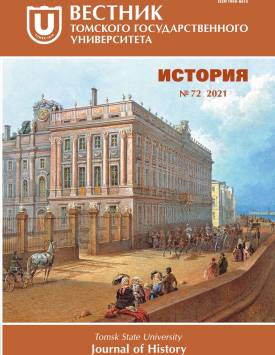Grain collection campaign of 1940/1941 in the Novosibirsk region
Aim of the article is to make detailed analytical reconstruction of course and results of grain collection campaign of 1940/41 in Novosibirsk region. Campaign was analyzed in the context of Soviet agrarian policy. Main attention was paid to organizational specifics of grain collection in collective farms, repressive component of state policy, and behavioral practices of peasantry. As basic sources for the article were used documents extracted from the funds of the State Archive of Novosibirsk Region (official clerical documents) and the Russian State Archive of Economics (statistical documents). It was found out that grain collection campaign of 1940/41 was managed under conditions of a significant increase in taxation of rural areas. Applied to grain collection, it was result of transition from calculating supply volumes by sowing area to calculating it from each hectare of arable land assigned to collective farms. It led to a significant increase in obligations to the state. In connection with increasing volume of machine and tractor work, plan rates for collecting natural tax increased. Also annual collection task for collective farms increased with arrears of past years. In Novosibirsk region and Altai burden of grain taxation increased in 1940/41 even more because of catastrophic crop failure in main bread-producing regions. Scheduled collection plan rates were not achieved systematically. Main factors hindering grain collection were crop failures, low labor discipline of collective farmers, which negatively affected pace of harvesting and threshing, grain loss during harvesting, excessive allocation of grain for natural prepayment, delayed export of threshed grain from storage to collection points, filling of natural funds before finishing grain collection. Low pace of grain collection provoked negative reaction from country's leadership, which required completion of procurement tasks. Under these conditions, to fulfill procurement plans again were used repressions, which first of all were directed against heads of collective farms. At the end of autumn, impossibility of procurement task became apparent for the Center, which facilitated tax burden. Annual plan rates were reduced. This decision allowed to increase percentage of procurement task completion. However, it was not fully completed. After the end of grain collection, many collective farms did not have opportunity to form food, feed and seed funds. Acute shortage of feed led to mass slaughter and mortality of livestock. In the winter of 1940/41 in the south-west of Novosibirsk region, as well as in Altai and north-west of Omsk region began famine. As a result, collective farms and Siberian rural area as a whole entered the Great Patriotic War weakened.
Keywords
Siberia, grain problem, collective farm system, grain collection, agriculture, agricultural policy of the Soviet stateAuthors
| Name | Organization | |
| Ilinykh Vladimir A. | Institute of History Siberian Branch of the Russian Academy of Sciences | agro_iwa@mail.ru |
References

Grain collection campaign of 1940/1941 in the Novosibirsk region | Tomsk State University Journal of History. 2021. № 72. DOI: 10.17223/19988613/72/5
